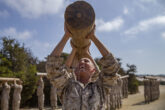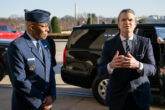December 10, 2019
Increasing Diversity in the Military: Recruiting and Retaining Talented Women
Testimony before the HASC Subcommittee on Military Personnel
I. Boots-on-the-Ground Assessment
Chairwoman Speier, Ranking Member Kelly, distinguished members of the Committee, thank you for the opportunity to discuss a topic I believe is of vital importance to the long-term strength of United States military. I want to begin with some personal examples of what drove me to enlist in the Army in 2000 – and then to not reenlist when my term was up in 2005.
A combination of factors inspired my military service. I grew up with a single mom; our precarious financial situation meant we were occasionally on food stamps and I got free or reduced price school lunches. The anxiety and shame of growing up in poverty was coupled with gratitude that the nation had invested in me. As a young adult, the military not only offered me enhanced financial stability, through both military training in valuable skills and access to higher education in the civilian sector via the GI Bill, but it also provided a way for me to repay the country for the lifeline it offered when I was a child. My deep appreciation for the social safety net has guided me toward a life of service and deepened my commitment to equality for all.
Luckily, I was able to meet accession standards for enlistment, something that today only 1 in 4 young people can do. And because the key disqualifiers – obesity, lack of a high school diploma, and criminal backgrounds – are more prevalent in poor communities, those who would potentially benefit the most from the military’s promise of a pathway out of poverty are least likely to be able to join. This is reflected in the socioeconomic backgrounds of those who serve today: those in the lowest income quintile are underrepresented compared to those in the middle class.
During my five years in the Army, which included a year-long deployment to the Middle East during Operation Iraqi Freedom, I acquired both tangible skills such as knowledge of Arabic and life-saving first aid, and invaluable intangible attributes such as perseverance and confidence. The latter, unfortunately, were often developed at great cost; the stresses of military life can enhance long-term resilience. Two particularly challenging areas that contributed to my choice not to continue serving disproportionately affect women: experiencing sexual misconduct and frustratingly outdated policies.
Download the full written testimony.
More from CNAS
-
National Security Human Capital Program
Defending the Army’s Command Assessment ProgramThe concept for CAP — developed during the first Trump administration — benefited from the guidance, input and oversight from the foremost scholar and practitioner on military...
By Katherine L. Kuzminski
-
National Security Human Capital Program
‘Women Don’t Just Achieve…They Excel’: Fmr. Marine Corps Attack PilotDr. Kyleanne Hunter, former Marine Corps attack pilot and CEO of Iraq & Afghanistan Veterans of America, says “women are the fastest growing group of veterans” and “the fastes...
By Dr. Kyleanne Hunter
-
National Security Human Capital Program
Could the U.S. Bring Back the Draft?In this episode of At the Boundary, GNSI’s Dr. Guido Rossi sits down with Katherine Kuzminski, Director of Studies at the Center for a New American Security (CNAS), to explore...
By Katherine L. Kuzminski
-
National Security Human Capital Program
Hegseth Brings the Culture War to CombatThe fundamental challenge of military leadership lies in creating cohesive teams that can work together in an environment of mortal risk and, when called upon to do so, use le...
By Dr. Jason Dempsey




